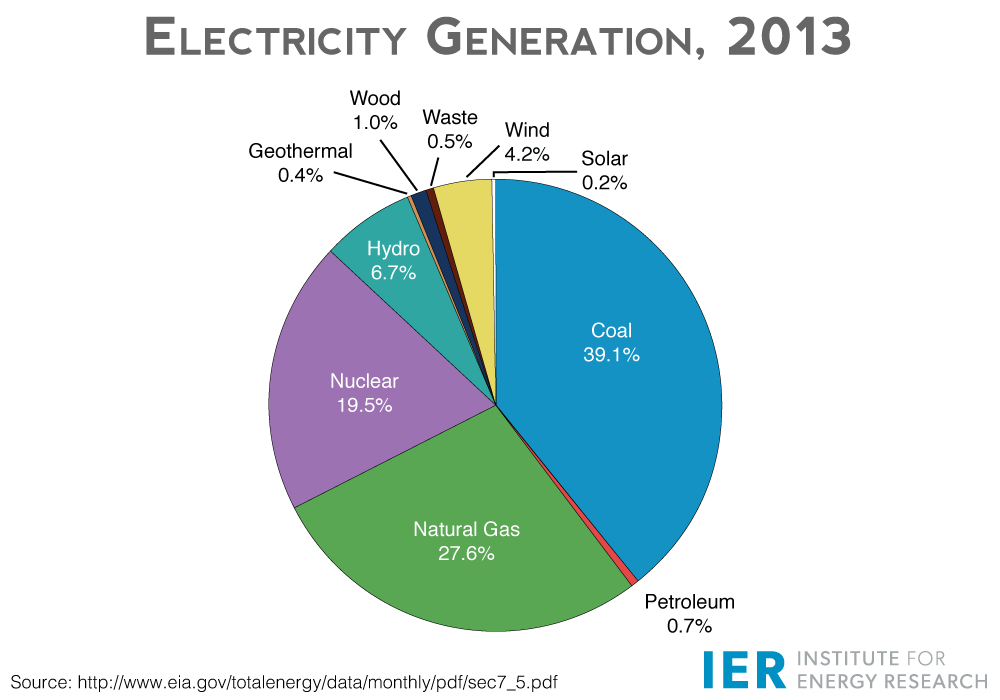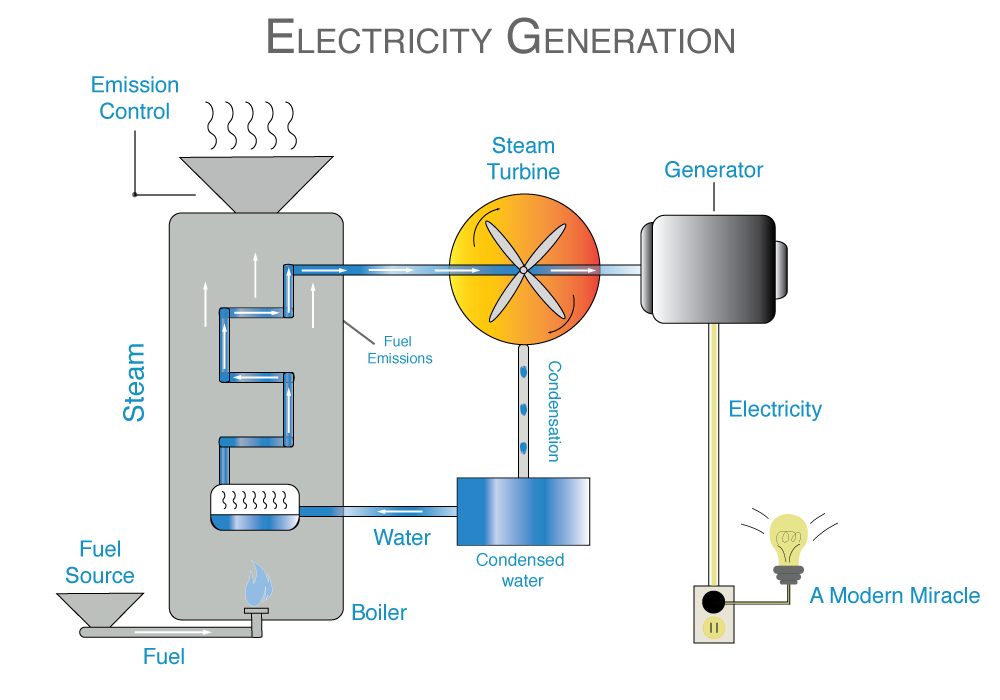Contents
- The History of Electricity Generation
- How Electricity Generation Works
- The Economics of Electricity Generation
- The Future of Electricity Generation
Electricity makes our lives better, brighter, and cleaner. But before it is transmitted on high-voltage power lines and then distributed to our homes and businesses, it needs to be generated by a power plant. This page focuses on electricity generation—the creation of electricity from another energy source. For example, the energy stored in chemical bonds within coal can be released via combustion and used to drive steam turbines inside power plants or the kinetic energy of the wind can be used to spin a wind turbine. The fundamentals of electricity generation (typically spinning magnets inside coils of wire) haven’t changed much over time, but the associated technologies have radically changed over time and are constantly evolving. Politics also plays a large role and influences the types of fuels we use for electricity, and politics will continue to drive major changes in the future.
The History of Electricity Generation
For the vast majority of human history, the setting of the sun limited people’s ability to do work or enjoy leisure time. Before electricity, people burned vegetable oil, wax, tallow, whale oil, kerosene, and gasified coal to light their homes and businesses. Electricity made it possible to have clean, safe, brilliant lighting without the hassle of burning fuels directly for light. When Thomas Edison opened the United States’s first central power plant in lower Manhattan on September 4, 1882, he permanently pushed back the darkness, creating a new world.[1] Edison’s new central power plant—the coal-powered Pearl Street Station—would become the prototype for the dawning power generation industry.
The Pearl Street Station featured six “jumbo” dynamo generators, each weighing 27 tons and supplying nearly 100 kilowatts of power (total output of about 600 kilowatts). Four coal-fired burners provided the steam energy necessary to turn the massive turbines that ran the generators.
Edison’s “central power plant” design was revolutionary—nothing like it had ever been built in the U.S. Using a central power station separated the energy user from the energy source, making everything from lighting to motors safer to use as well as cleaner, quieter, and more efficient. Edison had a grand vision for his model if it could work at Pearl Street: “Success meant world-wide adoption of our central-station plan.”[2]
Pearl Street was a success, and electricity took hold quickly. By 1890, a thousand central power plants had cropped up across the United States.[3] At the turn of the century, there were more than 30 different companies generating and distributing electricity throughout the boroughs of New York City alone.[4]
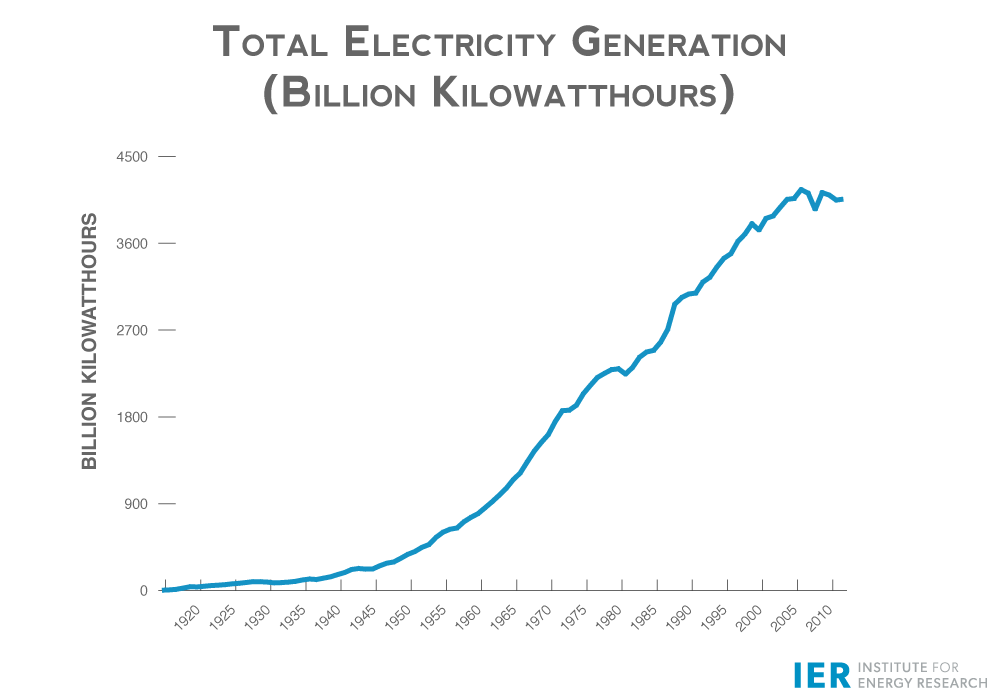
As people demanded more and more electricity to power their lives—to operate appliances, lights, streetcars, and factories—the competition to satisfy that demand resulted in larger power plants that provided an enormous amount of electricity. In 1901, Edison opened a plant in Brooklyn that was 20 times larger than the Pearl Street Station. Today, we have many power plants that are even 10 times larger than that. A single modern nuclear reactor produces 200 times as much power as Edison’s Pearl Street Station.
Edison Electric’s Pearl Street Station (1882): 600 kilowatts—enough electricity to light 10,000 60-watt light bulbs.
Brooklyn Edison’s Waterside Station (1901): 120 megawatts—enough electricity to light 2 million 60-watt light bulbs.
Modern nuclear reactors and coal plants (1970s–present): 1,200 megawatts—enough electricity to light 20 million 60-watt light bulbs.
How Electricity Generation Works
Thomas Edison used coal to fuel the first power plant. In the system he built, coal-fired boilers heated water, which produced high-pressure steam, which turned a turbine, which powered a generator. Spinning turbines account for the lion’s share of the electricity produced today. The process of using motion to produce electric current—via electromagnetic induction—was discovered by British scientist Michael Faraday 1831.[5] By spinning magnets inside of copper coils, Faraday was able to generate a small but measurable electric current. Modern power plants still use Faraday’s discovery, but they do so on a massive scale—the generators weigh several hundred tons and the current can power hundreds of thousands of homes.
Thermal Power
Although the process at the generator is similar across the board, the sources of energy used to spin the turbines vary greatly. The majority of the power in the United States comes from thermal generation—using heat to create high-pressure steam and drive turbines.[6] This is how coal, nuclear, and most natural gas plants produce electricity. In 2013, coal, natural gas, and nuclear power accounted for a combined 86 percent of total electricity generation in the U.S. (39.1 percent coal, 27.4 percent natural gas, and 19.4 percent nuclear).[7]
So how exactly do coal, nuclear, and natural gas plants work?
Modern coal-fired power generation is essentially a much larger, more efficient, cleaner, and technologically more advanced version of the steam-turbine process Edison used. Coal plants tend to keep about two months of fuel supply on-site, which limits any supply disruptions and makes them a reliable source of electricity. At the end of 2012, there were over 1,300 coal-fired power plants in the U.S. Coal produces more electricity than any other source—in 2013, coal power accounted for over 39 percent of total electricity generation in the U.S.
With nuclear power, steam is produced by heat released from a nuclear fission reaction (the uranium atom is split in a controlled process that emits a large amount of heat). There are 62 nuclear power plants operating in the U.S. (100 reactors total), and in 2013, nuclear power accounted for over 19 percent of total electricity generation in the U.S.[8]
Natural gas generation comes in two varieties: “simple cycle” and “combined cycle.” So-called simple cycle natural gas generation spins turbine blades directly through combustion, similar to a jet engine. Combined cycle natural gas generation has two combined pieces: the first is a simple cycle turbine generating power on its own, and the second is a separate steam turbine generating power using the exhaust heat from the combustion process.[9] For both types of natural gas generation, regional supply disruptions and severe price spikes caused by an inadequate pipeline infrastructure (particularly in the Northeast) threaten to undercut their reliable, affordable supply of electricity.[10] In 2013, power from natural gas accounted for over 27 percent of total electricity generation in the U.S.
Alternative Sources
Other power sources—particularly renewables—operate differently from thermal sources. For example, in hydroelectric power plants, flowing water spins the turbines.[11] Hydroelectric power is generally as reliable as thermal power, especially when its energy source (water holding potential energy) is stored behind dams in large reservoirs. A different type of hydroelectric power, called “run-of-the-river” hydro, runs turbines using river flow without a dam. Hydroelectric power is limited, however, by location—all hydro plants need a steady supply of water, and reservoirs require specific geographical conditions that simply do not exist in most areas of the country. Some regions benefit greatly from abundant hydroelectric resources. The highest concentration of hydropower in the U.S. is in the Pacific Northwest region, which is home to about 35 percent of the nation’s hydroelectric capacity.[12] In 2013, hydroelectric power accounted for nearly 7 percent of total electricity generation in the U.S.
Wind turbines use the natural movement of the air to produce electricity. These large structures—typically 300 to 400 feet tall—rely on a steady wind to turn the turbine blades and produce electricity.[13] Unlike the sources discussed above, wind power is at the mercy of weather conditions that change minute-to-minute, leading to intermittent and unpredictable electricity output. If the wind doesn’t blow, as is often the case during midday peaks in electricity demand, wind producers are literally powerless.[14] Wind resources (i.e. wind corridors suitable for electricity generation) are also most abundant in the plains of the Midwest U.S., meaning wind-powered generators are geographically limited and thus unable to provide power near population centers.[15] In 2013, wind power accounted for just over 4 percent of total electricity generation in the U.S.
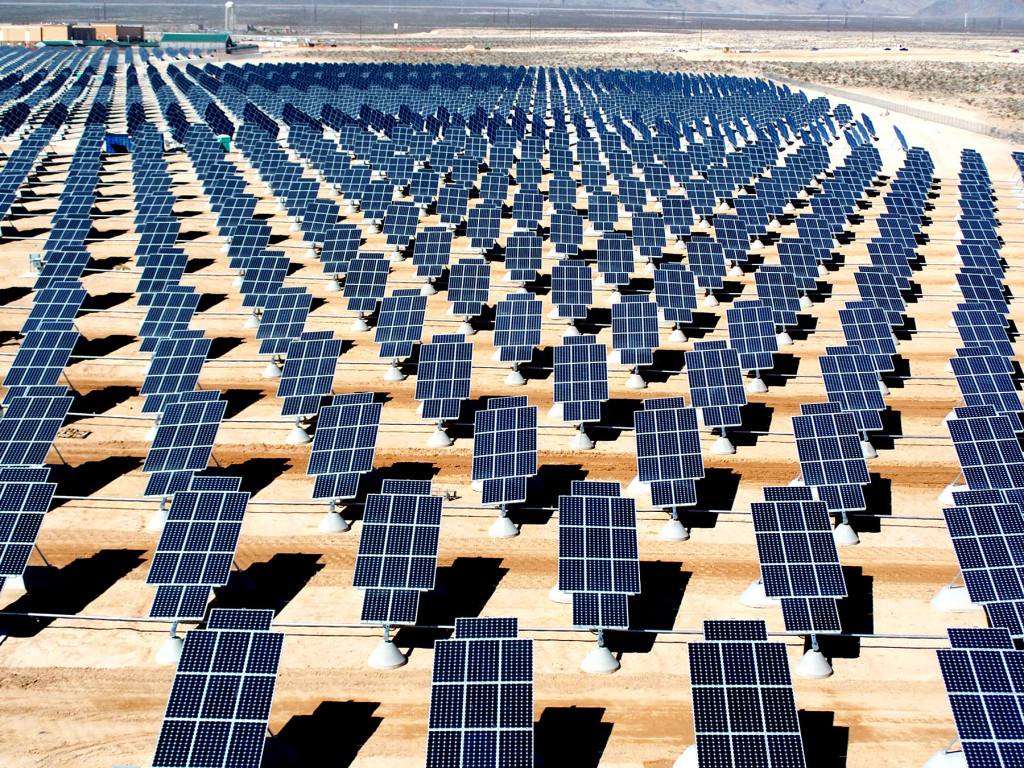 Solar PV facility
Solar PV facility
Photo Credit: Wikipedia Commons
Solar power comes in two main varieties: thermal and photovoltaic. Solar thermal power uses concentrated solar energy gathered by large arrays of mirrors to produce steam, which powers turbines in much the same way as other thermal generation. Photovoltaic solar panels are unique because they generate electricity directly from sunlight with no spinning turbines—no steam, rushing water, or wind. Photovoltaic panels are made up of solid chemical compounds or elements called semiconductors, such as silicon, that can conduct electricity under certain conditions. When sunlight hits the panels, the semiconductors absorb some of the energy, which knocks electrons loose and creates an electric current.[16] In 2013, solar thermal and photovoltaic solar accounted for 0.2 percent of the electricity needs of the U.S.[17] Like wind power, which only produces electricity when the wind blows, solar panels are limited to producing electricity only when the sun shines. Some regions of the U.S. are better suited to solar power than others—the best solar potential is in the deserts of the Southwest.[18]
The Economics of Electricity Generation
Power plants are expensive to build, but once they are up and running, they can produce huge amounts of electricity at low costs. Also, large power plants are generally cheaper per kilowatt-hour than smaller plants. This concept is referred to as “economies of scale,” and it explains why today’s power generation industry operates at such a large size. It is also the main reason why electricity consumers typically do not generate their own electricity—and why power plants tend to operate for several decades. Even solar panels—which renewables advocates claim are beginning to challenge large-scale generators—exhibit economies of scale.[19][20]
What power sources are cheapest? Generally speaking, the cheapest electricity comes from existing power plants. Electricity from existing nuclear, coal, and hydroelectric plants is inexpensive because in many cases the owners paid off the capital costs years ago. This is reflected in the map below, which shows the correlation between the use of coal for electricity and low retail rates. When it comes to building new power plants, however, new natural gas plants are the lowest-cost option according to the Energy Information Administration.[21]
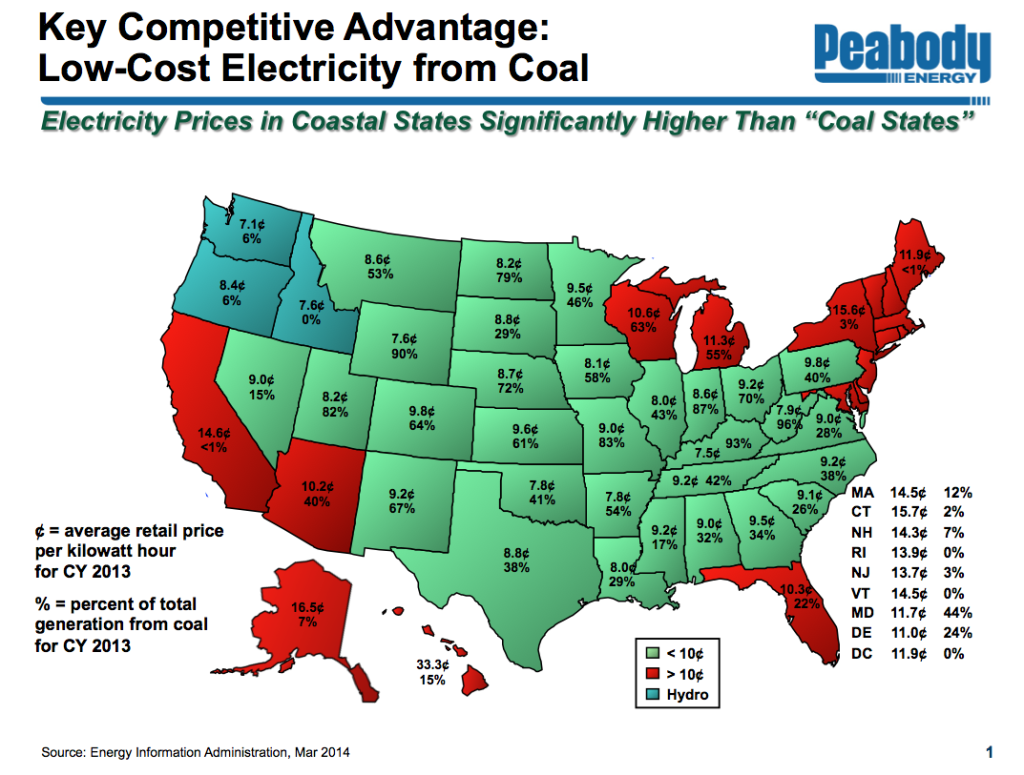 Source: Peabody Energy
Source: Peabody Energy
What power sources are most valuable? Not all sources of electricity generation are equally valuable. The most basic question is: How do we keep the lights on at the lowest cost? The sources of electricity generation that can provide reliable, on-demand power are the most valuable in terms of keeping the lights on.
The Economics of Traditional Sources
At all times, power grid operators need to maintain the delicate balance of the grid. Second by second, they must match the supply at their disposal (generation from power plants) with the fluctuating demand for electricity (also called electric “load”). Because grid balancing is paramount—no one tolerates a blackout—steady generation paired with generation that can adjust its output to follow demand is an incredibly valuable combination.
Over the course of the day, the demand for electricity varies as people wake up and start using electricity, turn on their A/C units to cool the houses during the day, watch TV, use computers and other appliances, etc. Electricity demand then falls as people stop those activities and go to bed. Some of the most valuable sources of electricity are the generators that can be relied on during peak periods of electricity demand.
What about power storage? Electricity has to be produced on demand because it is cost-prohibitive to store—huge batteries that have the capability to hold a power plant’s worth of electricity are technically feasible but incredibly expensive. Although it can be difficult to match supply and demand second-by-second, it is far cheaper than using battery storage.
Electricity demand is in constant flux, but it follows daily and seasonal patterns that electricity suppliers can anticipate. In order to meet demand in different parts of the day, different types of electricity generators are required. The three categories of generation are named according to the demand or “load” they serve. They are called “baseload” plants, “intermediate load” plants (also called “load following” plants), and “peak load” plants (sometimes called “peakers”). The graphic below shows electricity demand throughout an average day, with the types of power plants that are used to meet demand throughout the day.
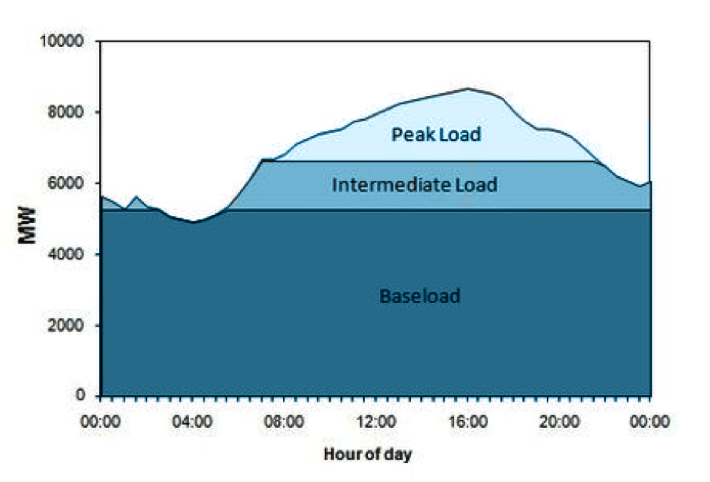
The baseload plants to handle the round-the-clock electricity demand. These plants run efficiently day and night. As electricity demand changes over the course of the day, “intermediate load” plants are turned on to follow the electricity demand and during the times of peak electricity “peak load,” also called “peaker” or “peaking” plants are turned on.These peak load plants run only when electricity demand is at its highest (or on-peak—hence the name).[23]
Baseload plants are typically coal and nuclear plants. These efficiently provide large amounts of reliable, inexpensive power but do not ramp up or down efficiently. It is difficult and inefficient to dramatically increase the electricity output from a coal or a nuclear plant.
Intermediate load plants are generally combined cycle natural gas plants. These plants can ramp up electricity production pretty efficiently but are most efficient when they run for a number of hours.
Peak load plants tend to be simple cycle natural gas or oil-burning plants. These plants can increase or decrease output very quickly (reaching full output within 10 to 20 minutes), but they are not as efficient as baseload or intermediate load plants and they are expensive to run.[23] Some peaker plants operate only sparingly on summer afternoons when electricity demand is highest.[24]
Hydroelectric plants are somewhat of a hybrid and can perform all of these functions if the plant has enough potential energy stored in water behind a dam.
All of these types of plants—low-cost baseload, flexible intermediate load, and peakers that operate on a premium—are critical to maintaining grid reliability by meeting demand at all times. These types of generation are all firm, meaning we can count on them to produce electricity when we need it. This is critical because the electricity grid needs to be kept in balance 24 hours a day, 7 days a week, 365 days a year, no matter the weather and no matter how many people turn on their lights, their air conditioning, or their TVs.
The Economics of Wind and Solar Generation
The previous discussion of baseload, intermediate load, and peaking power plants did not include wind or solar power. This is because wind and solar do not reliably provide baseload, intermediate, or peaking power. Instead of being able to control when wind and solar generation comes online, grid operators take intermittent electricity from wind and solar when the weather permits. The following chart shows that wind, on average, does not help keep the electricity grid in balance.
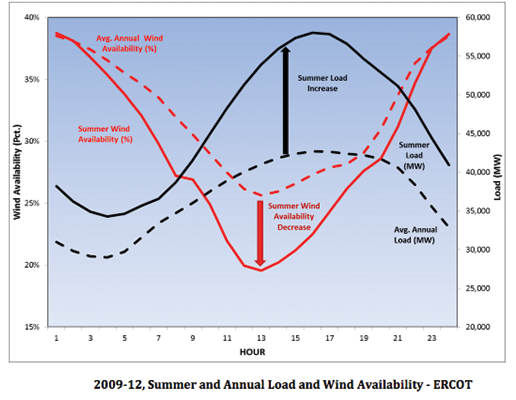 Source: Continental Econ
Source: Continental Econ
Not only does wind not follow the changes in electricity demand, but on average wind generates more power at night, when demand is lowest and wholesale prices can be very low or even negative.[25] Oversupply from wind facilities at off-peak hours has recently threatened to erode the economics of baseload plants and, in turn, threaten grid reliability.[26] From the point of view of wind producers, very low prices are not a problem because wind producers receive production subsidies on top of the wholesale price of electricity. In fact the wind production tax credit is so large that wind producers can pay the electricity grid to take their electricity and still make money.
Solar panels (by definition) work only during the day, and do a better job of helping to meet electricity demand, but still do not satisfy peak afternoon demand. As the following chart shows, solar generation falls off as total system demand reaches its peak. This places new stress on reliable generation sources, which have to pick up the slack and make up for the mismatch between solar power supply and electricity demand.[27]
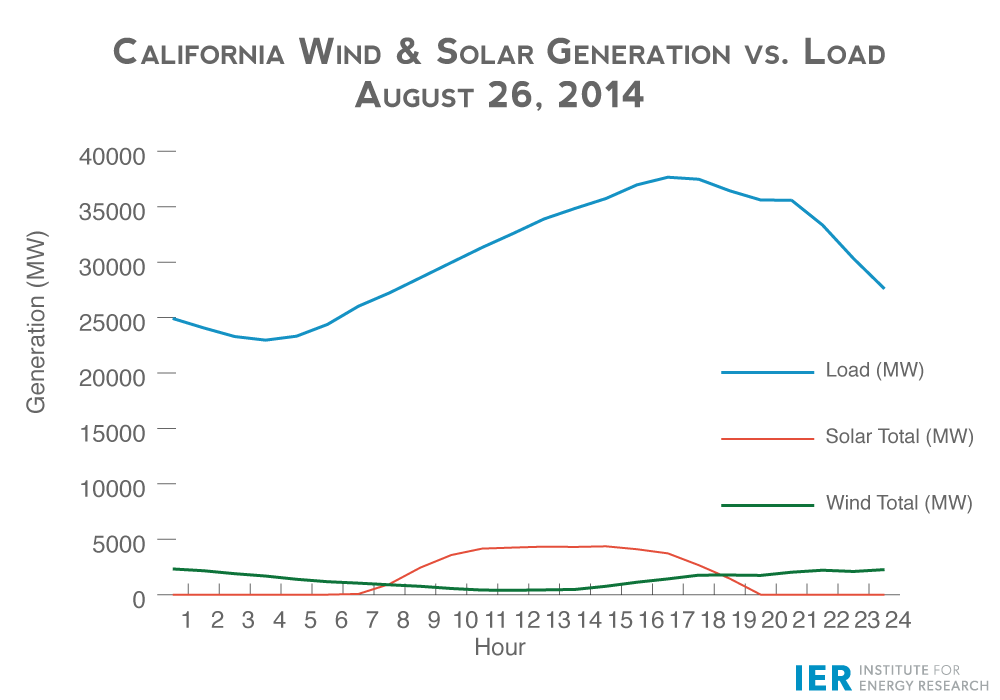 Source: Caiso
Source: Caiso
Off-peak generation might be valuable, however, when large-scale energy storage technology improves. Currently, one of the best technologies for shifting electricity generation from times of low demand to high is a hydroelectric technology called pumped storage. Pumped storage uses low-cost electricity at night to: 1) pump water into an elevated reservoir, 2) store it for several hours, and 3) meet the next day’s peak power demand like a regular hydroelectric dam. The process consumes more electricity than it generates, but it is profitable because it takes advantage of the unique economics of power generation that allow for using cheap nighttime power and then generating more valuable power during the day.[28] Aside from a few dozen pumped storage plants, affordable grid-scale storage in the U.S. remains elusive.[29]
The Future of Electricity Generation
The electricity generation industry is one of the most highly regulated industries in the United States, subject to regulation on the federal, state, and even local level. In the past, much of the regulation focused on providing affordable, reliable electricity, such as the economic regulation of utilities by state public utility commissions. But more recently, federal regulations have threatened to close the most affordable and reliable power plants while simultaneously propping up unreliable sources with mandates and subsidies.
A recent onslaught of rules from the Environmental Protection Agency is closing an unprecedented number of coal-fired power plants, which are the single largest source of electricity generation in the U.S. (over 39 percent in 2013).[30] These EPA rules do very little for the environment and come at a high cost to American families and businesses in terms of increased electricity rates and decreased grid reliability. National environmental organizations are now also attacking domestic natural gas and, by extension, the sizeable amount of electricity that is generated using natural gas (over 27 percent in 2013).[31] If these attacks on our two largest sources of electricity continue, our electricity supply will shrink. Without reliable generation to fill the gap, grid reliability will suffer and electricity rates will dramatically increase, which will drive up everyone’s cost of living and stunt economic growth.[32]
At the same time, dozens of federal policies subsidize unreliable generation from wind and solar facilities. The Government Accountability Office counted 82 different federal initiatives that support wind power.[33] One of the largest and most direct subsidies for wind power is the wind Production Tax Credit (PTC), which provides a tax write-off of 2.3 cents per kilowatt-hour of wind energy produced (nearly half the wholesale price of electricity).[34] Wind producers receive the subsidy no matter when they produce the power or what the going wholesale rate is. Also, because wind power production tends to be highest in off-peak hours, the subsidy itself is often more valuable to wind producers than the low off-peak wholesale price of electricity.
The PTC was not extended in 2013 and new wind installations plummeted, indicating that wind producers deem wind turbines unprofitable in many areas without federal support.[35] However, wind facilities qualify for the PTC for a 10-year period, and many facilities are still claiming eligibility starting in 2014 and 2015. As discussed above, heavy subsidies for off-peak production of electricity from wind facilities undermine grid reliability by artificially making baseload plants uneconomic.[36]
State-level policies also shape the generation sector. Currently, twenty-nine states and the District of Columbia impose Renewable Portfolio Standards (RPS) on utilities in their states. These mandates establish minimum amounts of electricity that must be generated by specific sources, typically wind and solar facilities or other renewables. Examples include a Kansas law that requires 20 percent renewable generation by the year 2020, a Nevada law that requires 25 renewable generation by 2025, and a California law that requires 33 percent renewable generation by 2020. Ohio is the only state so far to freeze or lower its RPS mandate, passing a law in June 2014 that freezes the mandate at 2.5 percent of total generation for two years.[37]
Conclusion
Thanks to the work of innovators like Michael Faraday and Thomas Edison, we have incredible electricity generation technology today, but we must continue to work to make sure our electricity is reliable and affordable for future generations of Americans. That starts with an appreciation of how far we have come and how fortunate we are to have uninterrupted access to the electricity that powers our lives.
[1] Edison opened a temporary power plant near Fleet Street in London in January 1882, which allowed him to test his Pearl Street design. http://americanhistory.si.edu/lighting/19thcent/promo19.htm
[2] Robert Bryce, Smaller Faster Lighter Denser Cheaper (New York, PublicAffairs, 2014) p. 31.
[3] Ibid.
[4] http://www.coned.com/history/electricity.asp
[5 http://www.engineering-timelines.com/how/electricity/generator.asp and http://channel.nationalgeographic.com/channel/cosmos-a-spacetime-odyssey/episodes/the-electric-boy/
[6] Edison Electric Institute, “How a Power Plant Works,” Electricity 101, http://www.eei.org/electricity101/pages/basics.aspx (June 30, 2014).
[7] http://www.eia.gov/totalenergy/data/monthly/pdf/sec7_5.pdf
[8] http://www.eia.gov/tools/faqs/faq.cfm?id=207&t=3
[9] http://naturalgas.org/overview/uses-electrical/, https://powergen.gepower.com/plan-build/tools-resources/power-generation-basics/combined-cycle-power-plants.html
[11] http://water.usgs.gov/edu/hyhowworks.html
[12] http://www.eia.gov/todayinenergy/detail.cfm?id=14931
[13] https://www.wind-watch.org/publication/nwwpub-size.pdf
[14] http://www.continentalecon.com/publications/cebp/Lesser_PTC_Report_Final_October-2012.pdf
[15] http://energy.gov/eere/wind/wind-resource-assessment-and-characterization
[16] http://science.howstuffworks.com/environmental/energy/solar-cell.htm
[17] http://www.eia.gov/electricity/monthly/epm_table_grapher.cfm?t=epmt_1_01_a
[18] http://www.blm.gov/wo/st/en/prog/energy/solar_energy.html
[19] How Solar Will Destroy The Power Companies, In 5 Easy Steps
http://www.businessinsider.com/how-solar-will-destroy-the-power-companies-2014-6 (accessed 8/28/14)
[20] A Review of Cost Comparisons and Policies in Utility-Scale and Rooftop Solar Photovoltaic Projects http://www.nrri.org/documents/317330/b549f302-f563-437f-87b7-36c7dc06d989 June 2014 (accessed 8/28/14)
[21] http://www.eia.gov/forecasts/aeo/electricity_generation.cfm
[22] http://www.kcet.org/news/rewire/explainers/explainer-base-load-and-peaking-power.html
[23] http://www.consumersenergy.com/content.aspx?ID=2180 (accessed 8/28/14)
[24] http://www.iso-ne.com/nwsiss/pr/2014/2014_summer_outlook_press_release_final.pdf
[25] http://www.continentalecon.com/publications/cebp/Lesser_PTC_Report_Final_October-2012.pdf
[26] https://www.instituteforenergyresearch.org/analysis/aweas-bold-push-for-more-wind-welfare/
[27] For a more in-depth assessment of what happens to reliable generation as total solar output increases, please see: http://blog.rmi.org/blog_2013_10_29_renewables_bird_problem
[28] http://energystorage.org/energy-storage/technologies/pumped-hydroelectric-storage
[29] http://www.eia.gov/todayinenergy/detail.cfm?id=13131
[31] http://content.sierraclub.org/naturalgas/
[33] http://www.gao.gov/assets/660/652957.pdf
[34] http://www.eia.gov/electricity/wholesale/
[36] https://www.instituteforenergyresearch.org/analysis/wind-ptc-threatens-grid-reliability/
[37] http://www.legislature.state.oh.us/bills.cfm?ID=130_SB_310



